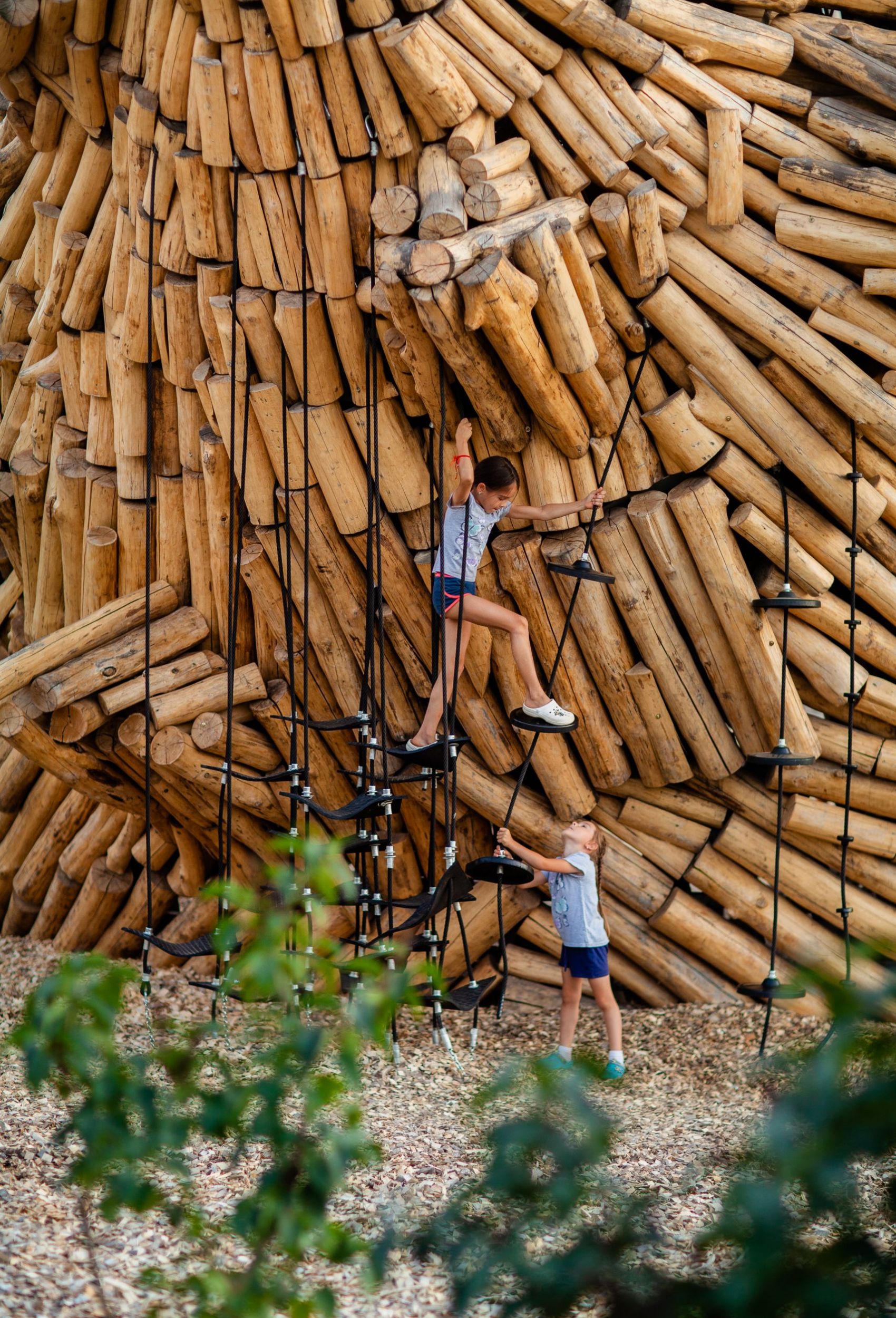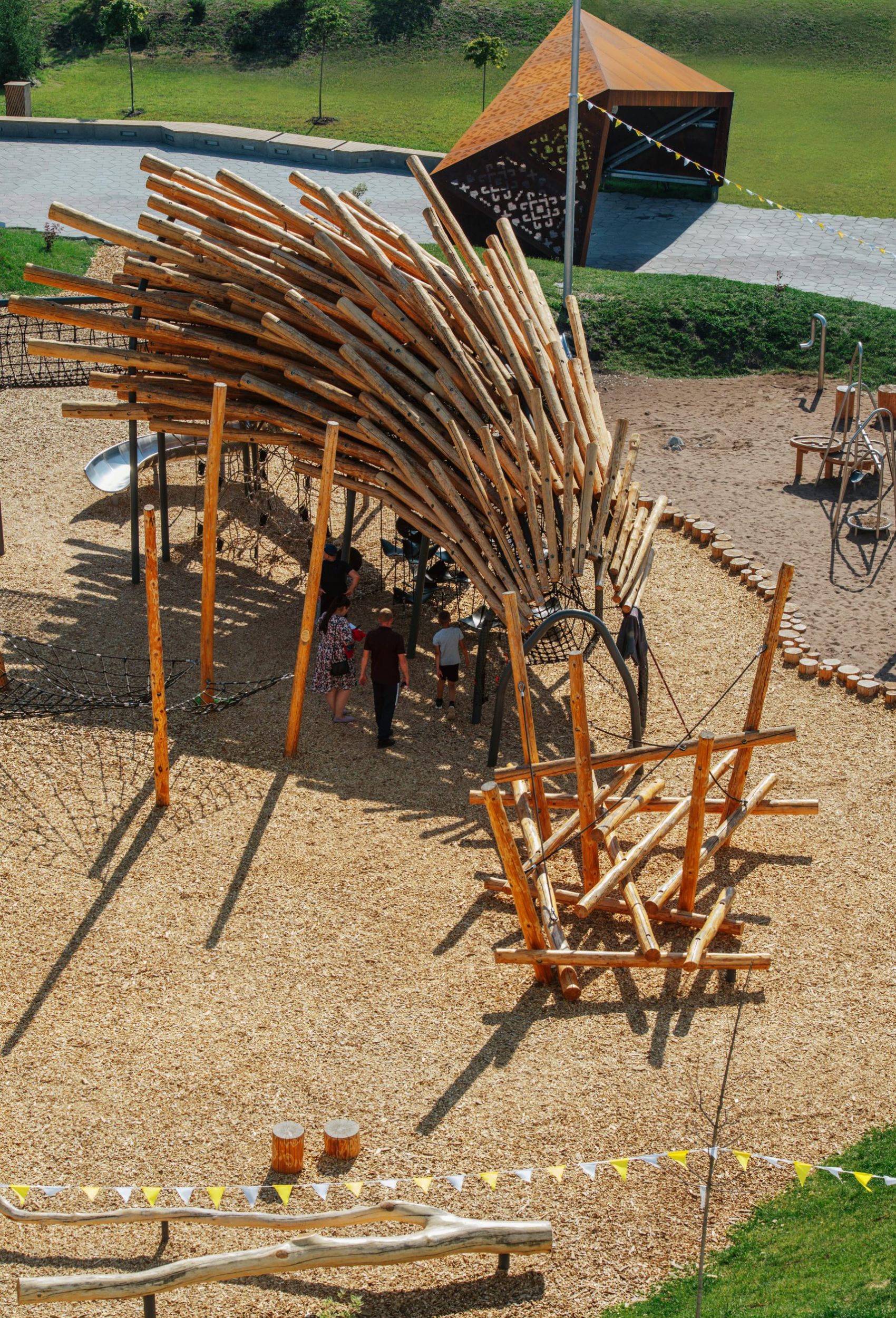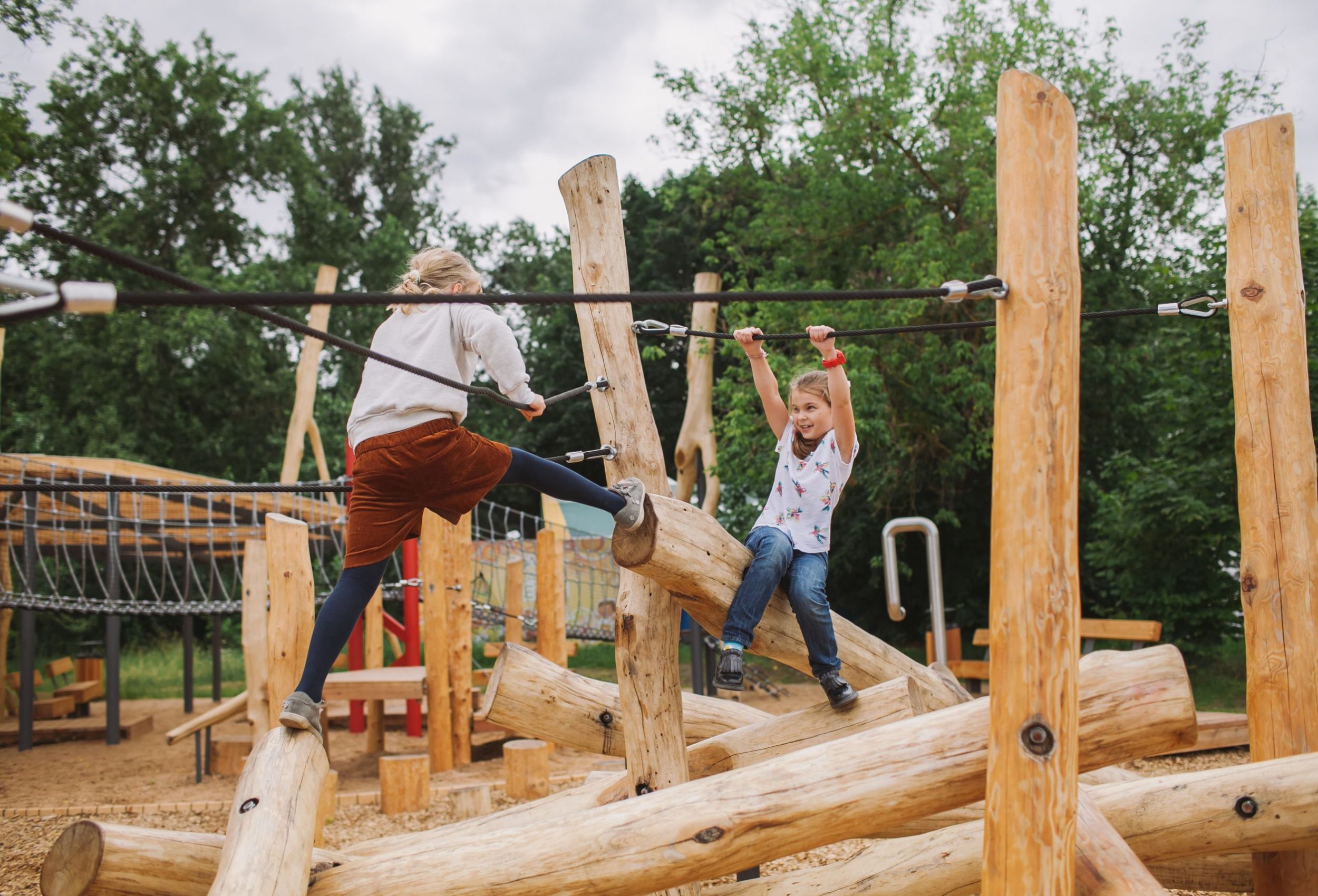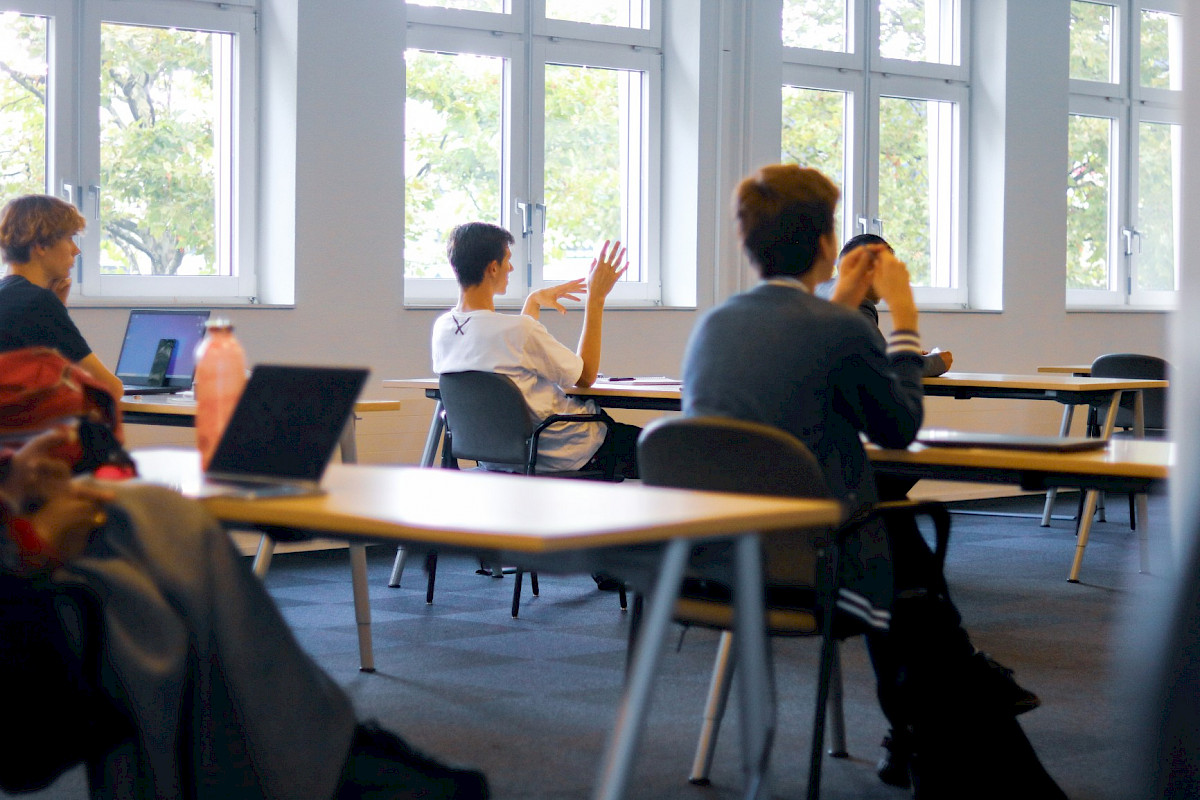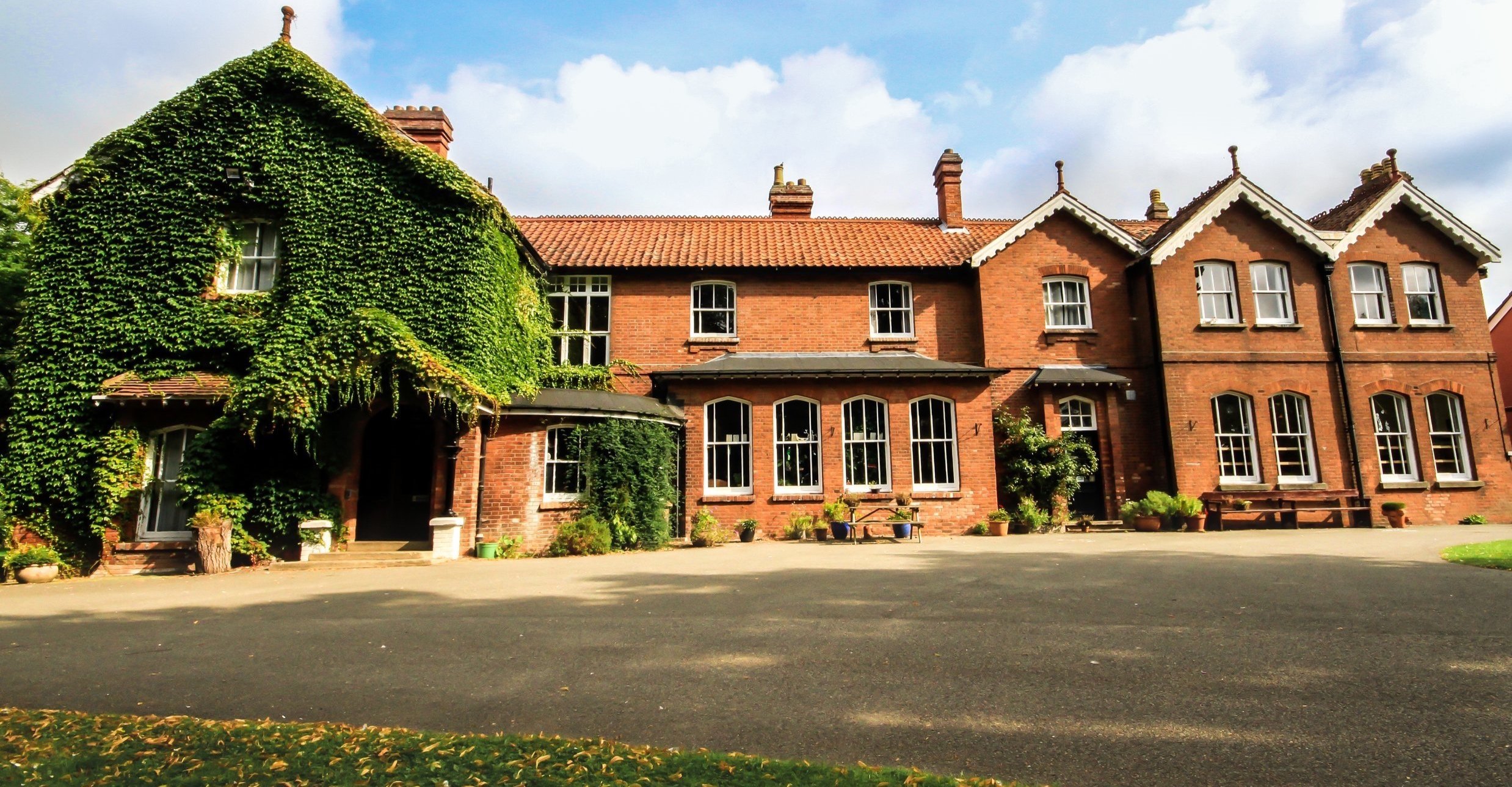When you are on a natural playground, it may seem that the elements are chosen at random: for example, logs are simply brought from the forest and placed on the territory, but this is not the case. Each game element is well-thought-through and performs a specific task on the playground. And all in all, they form an architectural ensemble, where the natural landscape of the area is taken into account. EdDesign Mag talked to Chekharda Bureau cofounder Darya Bychkova about the natural playgrounds’ most important characteristics.
The starting point for planning is observing children playing in the forest
Look at what they like: jumping on stumps and boulders, walking on fallen trees, keeping their balance, climbing up branches. Bring all this to the gaming environment in a concentrated form and in safe design. For example, climbing frames and bird’s nest climbing frames are limited by cables that you can grab when falling, and under them there is a shock-absorbing coating, the amount of which is calculated in accordance with the norms; all knots are stored in places where they do not pose a danger to the child, and are treated in a special way.
Even a small space is organised according to its own laws. Some areas are quite densely filled with play elements, and there are empty areas. The so-called “glade” in a natural playground is not just a free space on the plan, but an area where children of different ages meet and interact, a place for team games and activities. There are areas where children will definitely contact each other, and there are areas of solitude and independent play.
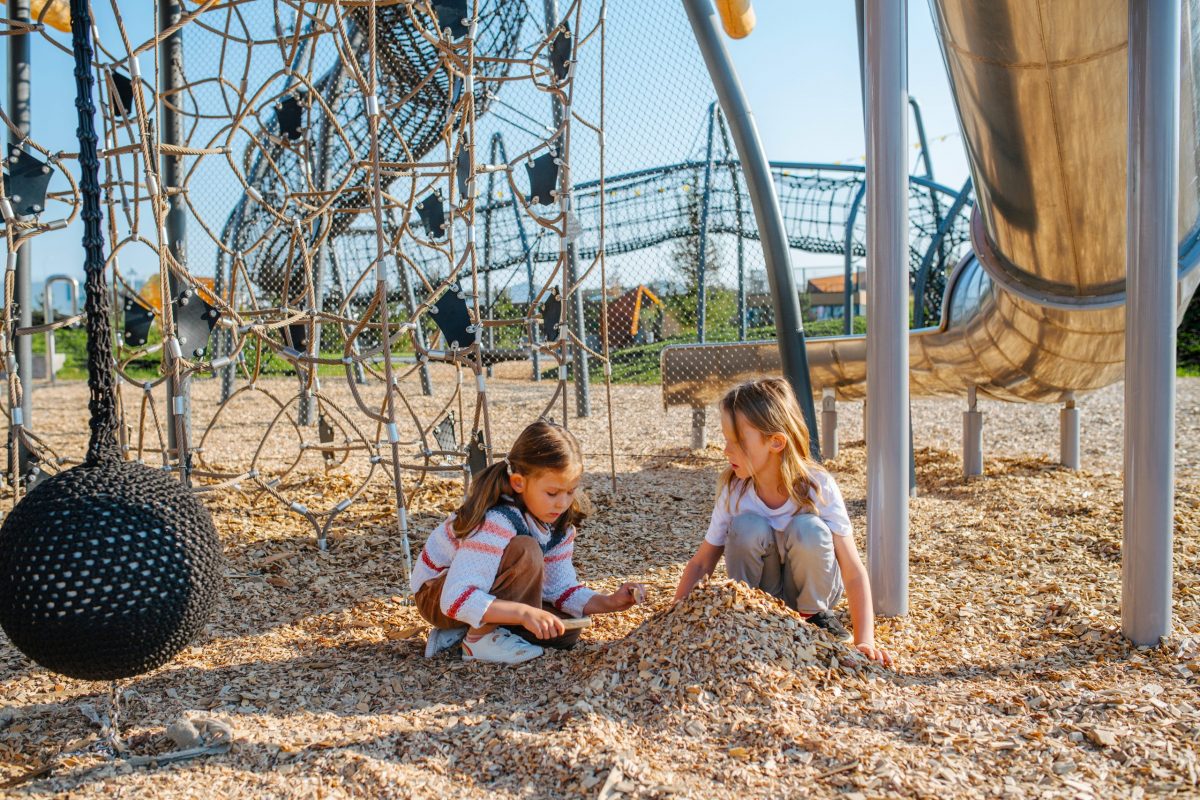
Composition: how to put different elements together
Proportions and composition are of utmost importance in any architectural object (details come as the second layer). The playground looks whole and beautiful, and is not perceived as a set of randomly placed game elements, when the correct size ratio of all its parts, especially the main form-forming details of the facility itself to the environment is found.
The main object of the playground either conquers the environment or mimics it. Proportions are verified from different points of approach: first of all, from the main ones, and then from the secondary ones. When the general outlines and geometric shape of the future facility are found, the architects begin to “sculpt” the image and work out the details.
How to provide a controlled risk
Natural playgrounds may initially frighten parents: they seem more dangerous because they look unfamiliar and out of the ordinary. However, accident statistics on natural playgrounds do not confirm that children are more likely to be injured on them than on traditional playgrounds.
Architects visit completed projects, observe how children behave, anticipate where, for example, they may trip and fall, and think through every movement of a child. In this way, risks can be mitigated: for example, by installing a catch rope or net, choosing the optimal height of the logs, i.e., creating an age-appropriate space with controlled risks.
It is important to use trees of unchanged geometry with preserved branches and limbs. In order for a curved tree trunk with branches to become, for example, a support for a swing or a bird’s nest climbing frame, it is necessary to calculate the support points and loads on it, predict the element operation taking into account the trunk bending, and guarantee that the structure will be able to bear this load.
The effort pays off. Game objects become more picturesque, more difficult to be perceived and more exciting. Complex curvilinear shapes are impossible to be remembered, which means they cannot get boring. That’s why, they are necessary in spaces where children regularly play in a limited area, such as a schoolyard.
Educational environment: what playground should be in the schoolyard?
The main task of a schoolyard playground is to provide a child with a good rest and to prepare his or her brain to perceive new information. It is important that the child does not return to class overexcited.
A study of school facades in Denmark has shown that some children’s channels of perception become disharmonised when playing on a playground with two or more colours, and children no longer adequately perceive reality. Therefore, according to the architects, the introduction of additional colour should be justified. There is no abundance of bright colours and sharp shapes on natural grounds. The main colours are the colours of wood, stone, sand, earth.
The playground scope is of great importance. For example, high slides increase the level of adrenaline, which leads to overexcitation. Therefore, it is better to refrain from game elements provoking the production of large doses of adrenaline at educational institutions, focusing on climbing frames and mazes. They promote concentration, provide a variety of physical activity, help children to distract themselves from their studies and return to class calm and rested.
It is worth considering areas for teachers and parents, driving routes, landscape elements and providing green spaces. Plants play a different role in yards: they are an object for research in biology lessons, a play environment, and an island of tranquillity where a child can relieve stress accumulated at school.
Choice of materials: natural ones and not only
An additional bonus of natural materials is tactility. In natural playgrounds, the child comes into contact with a variety of textures: these are smooth matte metal supports, rough wood, elastic rope tunnels, rustling wood chips and viscous sand, warm or cold, depending on the air temperature, stones.
The main material of natural playgrounds is wood; dense, elastic tree species, such as larch and oak, are suitable. The natural playground requires proper oil, fire retardant, antiseptic treatment. Then the surface of the logs itself does not require maintenance.
In addition to natural materials, ropes are used. On street playgrounds, these are composite six-strand vandal-proof ropes made of UV-resistant polypropylene threads with a steel core. Such ropes cannot be cut without the use of special electrical appliances. Ropes with a braid made of natural material can be used for a small play space at a kindergarten or private school.
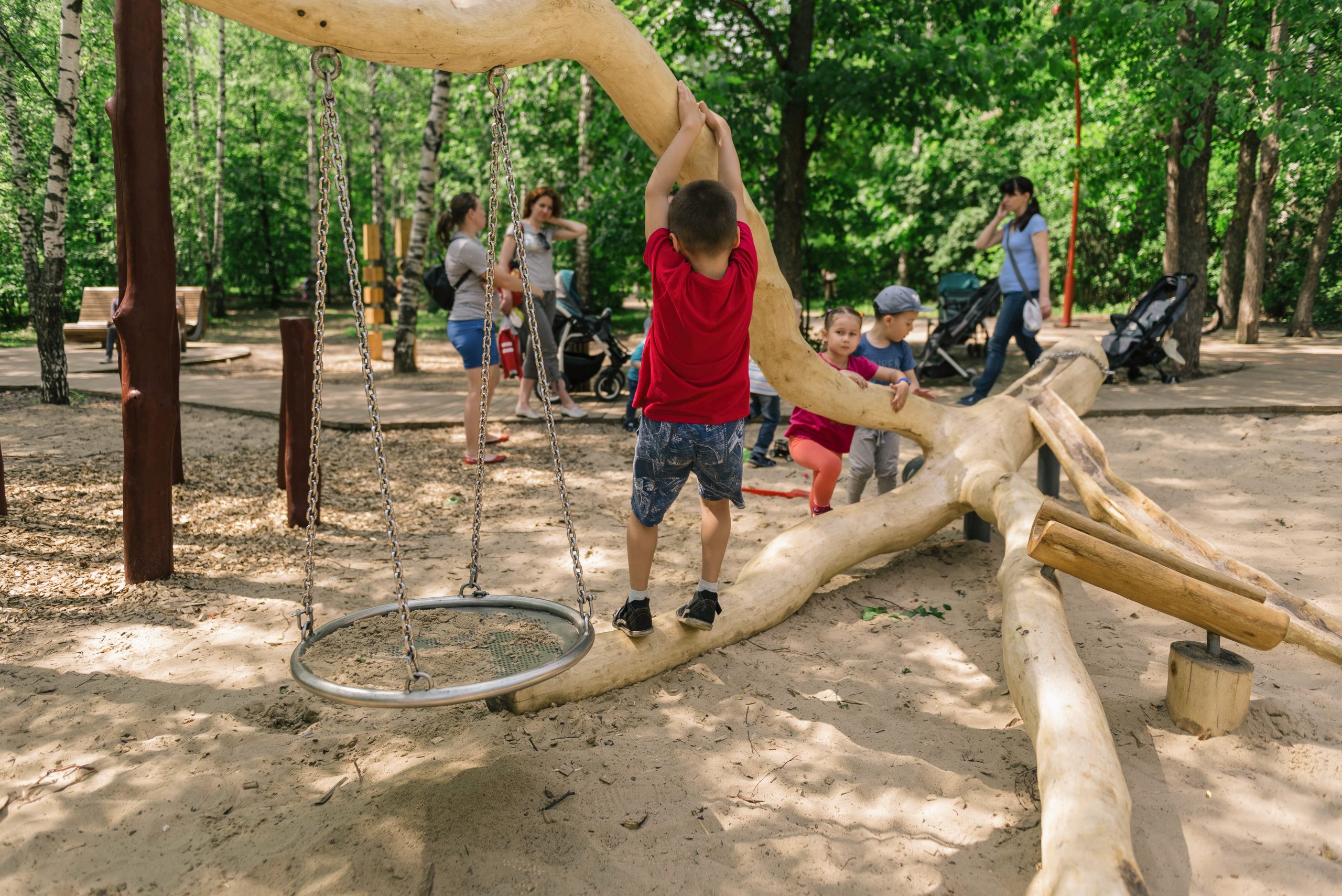
The natural playground can serve for several decades: one of the oldest playgrounds in Europe is more than 20 years old, and it is perfectly preserved. Unlike plastic and painted plywood, natural materials age beautifully and evenly. And this also has an educational aspect: children understand that the tree dries out, changes colour, but at the same time remains very beautiful, although in the end, like all living things, it dies and disappears from the face of the earth.
User impact: what is the effect?
Natural play spaces are coming to the city, responding to the urban dwellers’ demand for a more natural environment, developing and harmonising spaces within the urban environment. Recently, the deficit of communication with nature among city dwellers, and especially among children, has become so tangible that scientists have described it with the special term “nature deficit disorder”.
When a child is in a nature playground, even for a short time, he or she is immersed in the world of nature with its non-linear forms, natural colours and diverse textures. According to scientists’ research, such an environment helps to increase voluntary attention, relaxation, and improve short-term memory. Walking among natural surroundings reduces symptoms of ADHD.
The task of the playground designer is to offer a full range of game elements, as well as to restrict access to dangerous ones. For example, younger children will not climb the vertical maze that leads to a narrowed tower, thanks to this, they will not be at a height from which they will be afraid to get off. And children who are not physically fit enough to climb the vertical rope maze will not get on a high slide, from which it would be dangerous for them to go down.
How and what is developed during the game on natural playgrounds?
According to the research of Dawn Coe, professor of Kinesiology and Sports at the University of Tennessee, children are more involved in the game process on natural playgrounds and interact more with each other, move more actively. Children’s movement is not performed according to instructions, as it happens in the sports section or at a physical education lesson, but spontaneously, which contributes to optimal development.
For example, a log brought from the forest is unpredictable: a knot here, a bump there, a slight bend there. In order to process this information, the brain and visual system begin to work more intensively than when moving on a flat surface. And they send commands to our body that allow us to adapt to the variable. The same thing happens when a child climbs stumps, not stairs, when playing on a rope or log climbing frame, when interacting with non- standard game elements where there is no set algorithm and a clear program of actions.
The brain forms and strengthens new internal connections as the child solves motor problems, invents new movements, and experiments with the position of the body in space. Playing in a natural environment develops imagination and creativity. Thanks to the absence of set scenarios, the child comes up with stories based on what has impressed him or her in real life or what has made him or her think. This is how new information is learnt implicitly. Being in a natural environment, children not only invent games more actively, but also resolve conflicts more easily and successfully.
What ages are the nature playgrounds designed for?
Natural playgrounds cover the play needs of children from two to 15 years old. Each age group has its own set of elements that ensure a full play and development. Kids are comfortable in small, cosy spaces fenced off from the general area. Here they can safely play in the sand zone, which develops motor skills, as well as get basic skills of motor activity, for example, on stumps and logs.
Children of primary and secondary school age actively look for playmates among other children. They need freedom, the opportunity to test themselves. They like challenging climbing, 3D mazes, all the elements where you can test balance, strength and agility.
Teenagers prefer secluded corners or high vertical tunnels, where they could safely chat with friends while out of reach. In addition to nest shelters and towers, these requirements are also met by a bird’s nest climbing frame, upon which you can climb to watch others and talk with each other.
Photos: by Bureau Chekharda
November 2023




